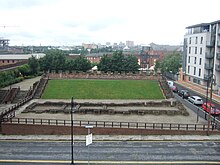Mamucium
A section of the fort's wall along with its gatehouse, granaries, and other ancillary buildings from the vicus have been reconstructed and are open to the public.‘Historia Brittonum’ (828-29) lists ‘Cair Maunguid’ (fort of the peat trees) and it has been suggested that this might be the authentic Welsh name for ‘Manchester’.The Romans built the fort on a naturally defensible sandstone bluff that overlooked a nearby crossing over the River Medlock.[14] Construction of Mamucium started around AD 79[15] during the campaigns of General Julius Agricola against the Brigantes after a treaty failed.Although it was again of turf and timber construction, it was larger than the previous fort, measuring 2 hectares (4.9 acres) to accommodate extra granaries (horrea).[21] It has sometimes been identified with the Cair Maunguid[31] listed among the 28 cities of Britain by the History of the Britons traditionally attributed to Nennius.It is then lowered to form the great entrance, the Porta Pretoria of the camp: the earth there running in a ridge, and mounting up to the top of the bank, about ten in breadth.And the whole of this wall, bears a broken line of thorns above, shews the mortar peeping here and there under the coat of turf, and near the south-eastern corner has a large buttress of earth continued several yards along it.And all this side of the wall, which was from the beginning probably not much higher than it is at present, as it was sufficiently secured by the river and its banks, before it appears crested at first with a hedge of thorns, a young oak rising from the ridge and rearing its head considerably over the rest, and runs afterwards in a smooth line near the level for several yards with the ground about it, and just perceptible to the eye, in a rounded eminence of turfAbout a hundred yards beyond the angle was the Porta Decumana of the station, the ground visibly rising up the ascent of the bank in a large shelve of gravel, and running in a slight but perceivable ridge from it.And beyond a level of forty five yards, that still stretches on for the whole length of the side, it was bounded by the western boundary of the British city, the sharp slope of fifty to the morass below it.The great foss of the British city, the Romans preserved along their northern side for more than thirty yards along the eastern end of it, and for the whole beyond the Western.And as the present appearances of the ground intimate, they closed the eastern point of it with a high bank, which was raised upon one part of the ditch and sloped away into the other.Mamucium was levelled as Manchester expanded in the Industrial Revolution.[9] When the railway viaducts were built, Charles Roeder documented the remains that were uncovered in the process, including parts of the vicus.[17] In 2001–05 the University of Manchester Archaeological Unit carried out excavations in the vicus to further investigate the site before the area underwent any more regeneration or reconstruction.





ManchesterCoordinatesCastlefieldNorth West EnglandcastrumRoman provinceRoman BritainRoman auxiliariesRoman roadsScheduled Ancient MonumentIndustrial RevolutionRochdale CanalGreat Northern RailwayLatinisationBrittonicbreastbreast-like hilllocal rivergoddessCeltic languagesneutersuffixplacenamesCommon BrittonicgenitiveWelsh namesandstoneRiver MedlocklegionaryDeva VictrixEboracumBremetennacumRibchesterCocciumCastleshaw Roman fortNorthwichtegulaeEbchesterHuddersfieldStone AgeMesolithicflintsNeolithicscraperBronze Agein situShropshire bullaCelticBrigantesSetantiiBritonsGeneral Julius Agricolatreatymain phasescohortRoman citizensforeign auxiliariesRoman armyrampartsgranaryhorreaAntonine ItineraryRoman Empiretemple to MithrasFortuna ConservatrixCounty Archaeologist"word square"PATER NOSTERamphoraRoman withdrawal from BritaincitiesBritainHistory of the BritonsNenniusantiquariansJohn LelandWilliam CamdenWilliam StukeleyJohn WhitakerJohn HorsleyCharles RoederManchester city centreDeansgateCastleshawA. J. P. TaylorProfessor Barri JonesUniversity of Manchester Archaeological Unittimber framedwattle and daubTempleborough Roman FortHistory of ManchesterScheduled Monuments in Greater ManchesterHistoric EnglandTheodor MommsenWayback MachineWikisource